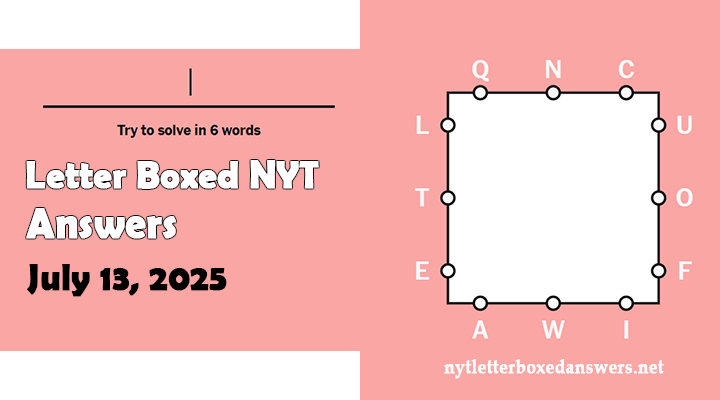NYT Letter Boxed quiz for Sunday July 13, 2025 is released. We came up with Letter Boxed July 13 2025 Answers and Hints for you. With the help of these hints, you will be able to guess the words of letter boxed quiz without revealing the answers and get the solution.
| Top | Right | Bottom | Left |
|---|---|---|---|
| QNC | UOF | AWI | LTE |
| Two Words Solution | ||
|---|---|---|
| LIQUEFACIENT | TOW | |
| LIQUEFACIENT | TOWLINE | |
| LIQUEFACIENT | TOWN | |
| LIQUEFACIENT | TOWNIE | |
| Three Words Solution | ||
|---|---|---|
| ACTINIC | COEQUAL | LOWLIFE |
| ACTINIC | COWL | LIQUEFACIENT |

Word 01:
This 12-letter word starts with L and ends with T; refers to a substance that causes liquefaction or the process of becoming liquid.
Often used in chemistry and pharmacology.
Can describe something that melts solids into liquids.
May be involved in phase changes or reactions.
Used historically for agents that dissolve or soften.
From Latin roots meaning “to make liquid.”
Can relate to turning organic matter into fluid.
Found in older medical and alchemical texts.
Opposite in effect to solidifying agents.
Not commonly used in everyday vocabulary.
Word 02:
This 3-letter word starts with T and ends with W; the act of pulling a vehicle or boat behind another.
Common with broken-down cars or boats.
Often associated with ropes, chains, or cables.
Appears in roadside assistance contexts.
Can also refer to coarse, broken flax or hemp fibers.
Used in naval or automotive terminology.
Has both noun and verb forms.
Seen in compound terms like “tow truck.”
May imply slow, careful pulling.
Pronounced like “toe,” despite spelling.
Word 01:
This 12-letter word starts with L and ends with T; refers to a substance that causes liquefaction or the process of becoming liquid.
Often used in chemistry and pharmacology.
Can describe something that melts solids into liquids.
May be involved in phase changes or reactions.
Used historically for agents that dissolve or soften.
From Latin roots meaning “to make liquid.”
Can relate to turning organic matter into fluid.
Found in older medical and alchemical texts.
Opposite in effect to solidifying agents.
Not commonly used in everyday vocabulary.
Word 02:
This 7-letter word starts with T and ends with E; a rope or cable used for towing.
Connects a pulling vehicle to one being towed.
Found on boats, aircraft, or land vehicles.
Essential for rescue or recovery operations.
Used to guide gliders into flight.
Can be made of synthetic or natural fiber.
May include hooks or fastening ends.
Stored on reels when not in use.
Used in both civilian and military settings.
Must be strong enough to handle load weight.
Word 01:
This 12-letter word starts with L and ends with T; refers to a substance that causes liquefaction or the process of becoming liquid.
Often used in chemistry and pharmacology.
Can describe something that melts solids into liquids.
May be involved in phase changes or reactions.
Used historically for agents that dissolve or soften.
From Latin roots meaning “to make liquid.”
Can relate to turning organic matter into fluid.
Found in older medical and alchemical texts.
Opposite in effect to solidifying agents.
Not commonly used in everyday vocabulary.
Word 02:
This 4-letter word starts with T and ends with N; a human settlement smaller than a city.
Larger than a village but smaller than a city.
May have its own local government and services.
Often surrounded by suburbs or rural land.
Central in historical development and trade.
Found in names like “Old Town” or “Georgetown.”
Can be defined by population or legal status.
Symbolizes community and infrastructure.
Opposite of countryside or rural area.
Common in geography, real estate, and culture.
Word 01:
This 12-letter word starts with L and ends with T; refers to a substance that causes liquefaction or the process of becoming liquid.
Often used in chemistry and pharmacology.
Can describe something that melts solids into liquids.
May be involved in phase changes or reactions.
Used historically for agents that dissolve or soften.
From Latin roots meaning “to make liquid.”
Can relate to turning organic matter into fluid.
Found in older medical and alchemical texts.
Opposite in effect to solidifying agents.
Not commonly used in everyday vocabulary.
Word 02:
This 6-letter word starts with T and ends with E; slang for someone who lives in a town, especially as distinct from students.
Often used near college campuses.
Can imply local resident versus transient visitors.
May carry either neutral or derogatory tone.
Found in UK and US university slang.
Contrasts with “students” or “tourists.”
May appear in TV shows or social commentary.
Describes people tied to the town’s culture.
Sometimes involved in “town and gown” conflicts.
Highlights social and demographic distinctions.
Word 01:
This 7-letter word starts with A and ends with C; relating to the chemical effects of light, especially ultraviolet rays.
Important in photography and medical imaging.
Describes light capable of initiating photochemical reactions.
Derived from the Greek word for “ray.”
Used in UV studies and sunscreen testing.
Can be dangerous in overexposure to skin.
Opposite of purely visible or thermal light.
Found in discussions of photosensitive materials.
Impacts photosynthesis and skin cancer research.
Common in physics, chemistry, and biology.
Word 02:
This 7-letter word starts with C and ends with L; someone or something equal in rank, status, or function.
Used in legal, social, or political contexts.
Highlights balanced or equivalent authority.
Often found in constitutional language.
Suggests parity in partnerships or power.
Seen in “coequal branches of government.”
Antonym of subordinate or inferior.
Reflects fairness and equal standing.
Can be used as adjective or noun.
Implies mutual respect and equivalence.
Word 03:
This 7-letter word starts with L and ends with E; derogatory term for someone considered morally or socially degenerate.
Often associated with criminals or unethical behavior.
Used in insults or harsh judgments.
Appears in crime fiction or slang.
Suggests lack of status, decency, or class.
The opposite of high society or respectable citizens.
May be tied to shady or underground activity.
Strongly emotional and pejorative.
Used to paint characters as villains.
Carries implications of danger or scorn.
Word 01:
This 7-letter word starts with A and ends with C; relating to the chemical effects of light, especially ultraviolet rays.
Important in photography and medical imaging.
Describes light capable of initiating photochemical reactions.
Derived from the Greek word for “ray.”
Used in UV studies and sunscreen testing.
Can be dangerous in overexposure to skin.
Opposite of purely visible or thermal light.
Found in discussions of photosensitive materials.
Impacts photosynthesis and skin cancer research.
Common in physics, chemistry, and biology.
Word 02:
This 4-letter word starts with C and ends with L; a hood or hooded garment, often worn by monks.
Associated with religious or medieval attire.
Can also mean a protective covering for machines.
Used in engines to cover components.
Symbolic of secrecy or anonymity.
Appears in fantasy or historical settings.
From Latin cucullus meaning hood.
May also refer to chimney tops or cowling.
Worn for warmth, ritual, or disguise.
Visually dramatic in film or theater.
Word 03:
This 12-letter word starts with L and ends with T; refers to a substance that causes liquefaction or the process of becoming liquid.
Often used in chemistry and pharmacology.
Can describe something that melts solids into liquids.
May be involved in phase changes or reactions.
Used historically for agents that dissolve or soften.
From Latin roots meaning “to make liquid.”
Can relate to turning organic matter into fluid.
Found in older medical and alchemical texts.
Opposite in effect to solidifying agents.
Not commonly used in everyday vocabulary.

Chris Brown is a passionate word game love and problem solving expert. With over 15 years of experience in solving puzzle challenges, he provides daily NYT Letter Boxed answers, tips and strategies to help other players so that they can improve their solving skills. Whether you are stuck on a tricky puzzle or looking for new techniques, Chris is here to guide you with his expert solutions.